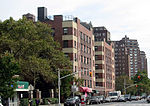Baruch Houses

Bernard M. Baruch Houses, or Baruch Houses, is a public housing development built by the New York City Housing Authority (NYCHA) on the Lower East Side of Manhattan. Baruch Houses is bounded by Franklin D. Roosevelt East River Drive to the east, E. Houston Street to the north, Columbia Street to the west, and Delancey Street to the south. The complex, the largest NYCHA development in Manhattan, occupies 27.64 acres (111,900 m2) (equivalent to fifteen blocks), of which buildings cover 13.4%, a percentage similar to that of most "tower in the park" project designs. It has 2,194 apartments, which house an estimated 5,397 people. These apartments are distributed throughout 17 buildings. Baruch Houses I is seven stories tall, Baruch Houses XI, XIII, and XV are thirteen stories tall, and the rest (II-X, XII, XIV, XVI-XVII) are fourteen stories tall. Combined, these buildings have 2.9 million square feet (270,000 m2).Baruch Houses Addition, or Baruch Addition, is an eighteenth building for seniors, built in 1977. Baruch Addition is located on Columbia Street, at the start of Rivington Street, and has 197 units in twenty-three stories.
Excerpt from the Wikipedia article Baruch Houses (License: CC BY-SA 3.0, Authors, Images).Baruch Houses
Stanton Street, New York Manhattan
Geographical coordinates (GPS) Address Nearby Places Show on map
Geographical coordinates (GPS)
| Latitude | Longitude |
|---|---|
| N 40.7175 ° | E -73.9772 ° |
Address
Baruch Playground
Stanton Street
10002 New York, Manhattan
New York, United States
Open on Google Maps








